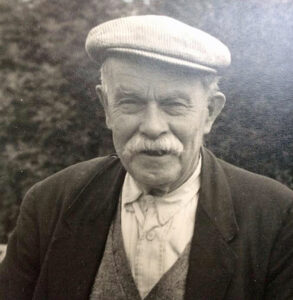 Charles Chegwyn
Charles Chegwyn
By Tony Mansell
Henry Chegwyn (1829-1924), Charlie’s father, was born and died in Trevella, a house in Algers (Algiers on maps), Feock, which his father had built. He was a stonemason and at least two of his children, including Charles who is the subject of this article, followed him into that trade.
On the 23rd December 1852, Henry married Catherine Kinsman, and during the years up to her death in 1888, they had eleven children, all born at Trevella. Henry was musical and often played a flute to lead the singing in the church or chapel: at least four of their children had a musical involvement.
Charles Chegwyn (pronounced Schegwyn) was born on the 28th December 1868 and a number of people have expressed surprise that it was in Feock and not St Agnes. He was the third youngest in the family. We know little about the young Charlie, other than, like many other young people, he had a hobby of whittling: he made miniature objects including a ship which he inserted into a bottle.
When he was a young boy he found a broken tin whistle on which he could play three or four notes. He would go up and down these notes until his mother would say, “Charlie, do put that whistle away for a little while”. Herbert, Charlie’s brother, said that his fingers were small, especially his fingertips and this helped when playing musical instruments. He added, “When he was a young fellow, he could play several instruments well. Sometimes he enjoyed a ‘mad gallop’ with the violin, that’s playing it as fast as he could. When he was older, he contented himself with playing the double bass in the St Agnes Band.”
It seem, however, that he continued with a varied musical involvement, at least for a while, as a report in the Cornubian and Redruth Times of Saturday the 29th April 1905, refers to him playing the flute at a service in St Agnes Parish Church.
In the 1881 census Charlie is recorded as a 12-year-old scholar, living with his family in Feock.
When writing the book St Agnes and its Band I had assumed that Charlie began his band career in 1907 when St Agnes Town Band was formed. I did not state that as a fact but it was what I thought. Thanks to some further newspaper reports sent to me by Susan Coney of Truro, I now know that is not the case.
The West Briton and Cornwall Advertiser in May 1955 records that he had been a bandsman for 73 years, placing his brass band debut as 1882. By then he would have been 13 or 14 years of age and, no doubt, working. What we cannot be sure about is the date when he moved to St Agnes. If his work had brought him to there at that early age then his band career most probably started with one of the two St Agnes Bands, either the St Agnes Red Coats Band, which had existed since the 1850s or earlier, or with the St Agnes Independent Band, which had recently been formed. If, however, he had yet to move to the St Agnes area then it may have been with Feock Brass Band. By about 1890 St Agnes Independent Band had ceased to function and within a few years, certainly by 1900, the St Agnes Red Coat Band had followed them. So, no clues there as to in which band Charlie played.
Many years later Charlie recalled an unusual and amusing incident from when he was a youngster. “In the 1880s, we had small bands of about ten to a dozen people with oddly assorted instruments. Often, these were already so old that we had to stop them up with soap to prevent the air leaking. I mind this dodge worked well until one day, when on the march, it started to rain and before long we were all blowing bubbles!”

In 1891 Charlie was 23 years old and living in St Agnes Parish. He was working as a stone mason (he was later referred to as a master stone mason) and lodging at Wheal Rock (the area which is almost certainly at West Kitty) with Mary Tregellas, a widow and office caretaker, and her daughter, Elizabeth (Bessie), aged 17. Three years later Charlie and Bessie were married but no evidence of them having had any children has been found.
As an aside, whilst writing this article, Paula Ford, Charlie’s great niece, alerted me to the fact that Elizabeth (Bessie) Chegwyn and I are related through the Paddy line: a surprising coincidence.
Paula is researching the Chegwyn family history and suggests that Charlie set sail for Cape Town, South Africa, on the 6th of June 1900. This fact is included on Ancestry.co.uk records where it states that the reason for his trip was to help in the construction of a reservoir on Table Top Mountain. It states that it was a period of civil unrest (no doubt because of the Boar War) with many British folk moving away from the interior of South Africa at that time. Paula says that the ship’s passenger list shows him registered as a clerk, which is very strange as he was a stone mason. She also believes that both Charlie and Betty travelled to South Africa again a few years later, this time he was registered as a miner. These details are clouded with mystery and Paula is still trying to unravel them.
Anyway, by the time of the 1901 census, he was back in St Agnes where he remained for the rest of his life. By this time, Mary Tregellas was living in Churchtown, St Agnes (almost certainly at No. 2), with her daughter Elizabeth, her son-in-law, Charlie and four boarders. It would seem a reasonable assumption that this was the family home from sometime between 1891 and 1901 to 1964, when Charlie died.
In A Millennium Chronicle, Frank Carpenter states that in June 1902, at the end of the Boar War, “Goonown Brass Band provided the music and was followed by hundreds of villagers”. Also, the West Briton and Cornwall Advertiser of the 19th June 1902 reported that “For some weeks the young men of Goonown have been busy organising a Brass Band, with a view to participating in the local Coronation celebrations”. It therefore seems likely that Goonown Brass Band was formed during a period when St Agnes had no band. There were other reports of this band although the West Briton and Cornwall Advertiser of the 21st April 1904 refers to it as St Agnes Brass Band. So, had one of the old bands lingered on or is the newspaper reporter’s pencil at fault again. Knowing Charlie’s love of the brass band, it seems likely to me, that he would have been involved in this band wherever they were located and whatever they were called.
The first hint we have of a new brass band for St Agnes was in the Royal Cornwall Gazette of the 5th September 1907 when it declared: “It is rumoured a brass band is to be started immediately [at St Agnes]. We hear a drummer has been secured and a good drummer, it is said, goes a long way to making a band.” As it turned out, their information was correct and at a meeting later in the month it was resolved to form a band, to be known as the St Agnes Town Brass Band. John Paull was to be the bandmaster and Charlie Chegwyn was one of its founder members.
Within a short period of time, in May 1908, the “Philharmonic Band”, under Mr John Paul, was performing in public and at a concert at Zelah, C Chegwyn and J Northey were the soloists. Proof, if proof were needed, that it comprised experienced players and not recent beginners.
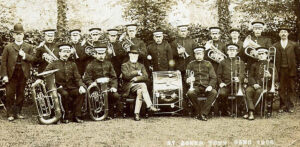 Probably the first formal photograph of St Agnes Town Brass Band, in 1908, with Charlie second left in the front row (Photo: courtesy Clive Benney)
Probably the first formal photograph of St Agnes Town Brass Band, in 1908, with Charlie second left in the front row (Photo: courtesy Clive Benney)
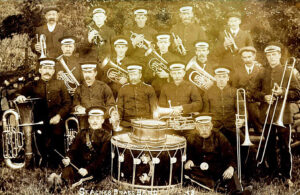 Another photograph of St Agnes Town Band in 1908 – Charlie is second left, seated (Photo: courtesy Clive Benney)
Another photograph of St Agnes Town Band in 1908 – Charlie is second left, seated (Photo: courtesy Clive Benney)
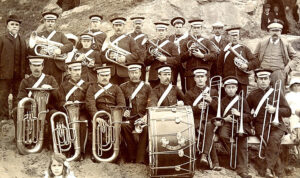 St Agnes Town Band 1909 with Charlie extreme left in the front row (Photo: courtesy Clive Benney)
St Agnes Town Band 1909 with Charlie extreme left in the front row (Photo: courtesy Clive Benney)
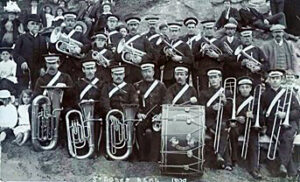 St Agnes Town Band 1909 with Charlie extreme left in the front row (Photo: courtesy Clive Benney)
St Agnes Town Band 1909 with Charlie extreme left in the front row (Photo: courtesy Clive Benney)
In 1911 the Royal Cornwall Gazette reported that the St Agnes Town Band (under Bandmaster Harry Robins) contributed an excellent programme and that Mr Chegwyn, the handyman of the band, played a solo. From that we can deduce that Charlie was a good player as it was unusual in those days for a bass player to perform a solo.
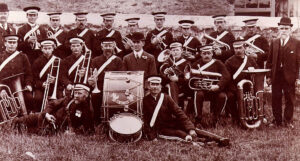 St Agnes Town Band on the 22nd June 1911 on the occasion of the Coronation of King George V – Charlie is seated on the extreme right (Photo: courtesy Clive Benney)
St Agnes Town Band on the 22nd June 1911 on the occasion of the Coronation of King George V – Charlie is seated on the extreme right (Photo: courtesy Clive Benney)
A milestone in Cornish brass band history was the first West of England Bandsmen’s Festival (Bugle Contest) in 1912, an event which still takes place in 2022. St Agnes competed at this inaugural contest when they were placed 4th out of the six bands in Class B. Charlie was playing on that day and no doubt experienced the same tension and emotions as those who play there now.
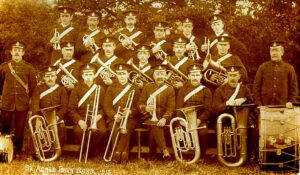 St Agnes Town Band in 1913 with Charlie seated on the extreme right
St Agnes Town Band in 1913 with Charlie seated on the extreme right
By 1914, St Agnes Band had been in existence for just six or seven years but despite that, the committee and players felt able to organise a brass band contest. It was held on the 16th of May and the intention was that it should be an annual event but the disagreement in Europe intervened and it was never repeated. The newspaper headline read “Large Crowd Enjoy Delightful Competition” and the event appears to have taken place in “glorious weather” and to have involved “excellent arrangements”. It goes on to say that there were, “prizes to the value of £38 and the arrangements were made by St Agnes Town Band [Bandmaster H Robins], with Mr R Waters as President; Mr H R Wills, Hon. Secretary; Mr C Chegwyn, Hon. Treasurer; and Messrs Prisk, J Pope, J Angwin and A Jones, committee”.
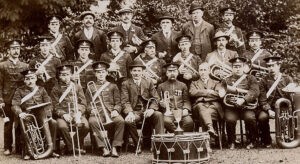 St Agnes Town Band on the 4th August 1914, the day Britain declared war on Germany. It commemorates a win at Truro Band Contest and the negligent newspaper reporter stated that Charles Chygrin (sic) was seated on the extreme right.
St Agnes Town Band on the 4th August 1914, the day Britain declared war on Germany. It commemorates a win at Truro Band Contest and the negligent newspaper reporter stated that Charles Chygrin (sic) was seated on the extreme right.
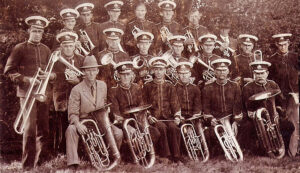 St Agnes Town Band in the early 1920s with Charlie in the front row – extreme right (Photo: courtesy Clive Benney)
St Agnes Town Band in the early 1920s with Charlie in the front row – extreme right (Photo: courtesy Clive Benney)
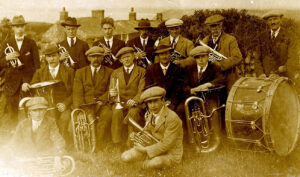 St Agnes Town Band circa 1922 with Charlie and future musical director Frank Moore seated at each end of the centre row
St Agnes Town Band circa 1922 with Charlie and future musical director Frank Moore seated at each end of the centre row
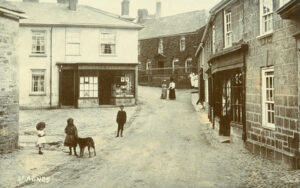 Churchtown 1902 with Ivy Cottage in the distance (Photo: courtesy Clive Benney)
Churchtown 1902 with Ivy Cottage in the distance (Photo: courtesy Clive Benney)
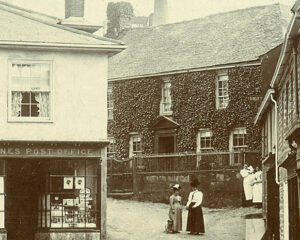 Ivy Cottage was built circa 1750 and it is easy to see why it became so named. Bessie and Charlie lived there from about 1900. (Photo: courtesy Clive Benney)
Ivy Cottage was built circa 1750 and it is easy to see why it became so named. Bessie and Charlie lived there from about 1900. (Photo: courtesy Clive Benney)
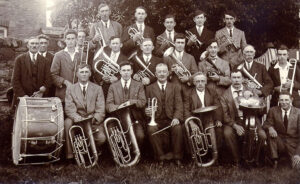 St Agnes Town Band 1926 with Charlie to the right holding the bell of his bass (Photo: courtesy Clive Benney)
St Agnes Town Band 1926 with Charlie to the right holding the bell of his bass (Photo: courtesy Clive Benney)
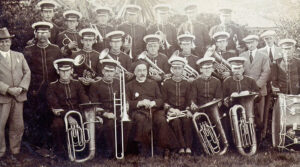 St Agnes Town Band at the 1929 St Agnes Church fete with Charlie seated on the right (Photo: courtesy Clive Benney.)
St Agnes Town Band at the 1929 St Agnes Church fete with Charlie seated on the right (Photo: courtesy Clive Benney.)
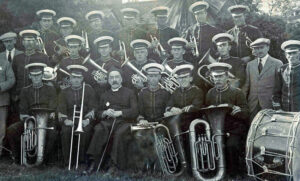 St Agnes Town Band at the 1929 St Agnes Church fete with Charlie seated on the right (Photo: courtesy Clive Benney)
St Agnes Town Band at the 1929 St Agnes Church fete with Charlie seated on the right (Photo: courtesy Clive Benney)
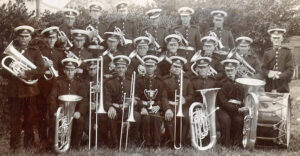 St Agnes Town Band 1930s with Charlie seated on the right (Photo: courtesy Clive Benney)
St Agnes Town Band 1930s with Charlie seated on the right (Photo: courtesy Clive Benney)
St Agnes Band took part in many local contests with varying success. At the 1938 Redruth Contest they were unplaced but they did pick up a number of special awards around this period including several by Victor Trezise on euphonium, Tommy Aver on horn and, in 1935, at Falmouth, by the bass section which comprised Charles Chegwyn, Frank Moore, W Sandercock and George Repper.
In a registration document dated 1939, the Chegwyns are living at No. 2 Churchtown, St Agnes. Charles (born 28th December 1868) is referred to as a “Wall Mason” and Elizabeth (born 4th October 1873) is stated as “Unpaid Domestic Duties”. Presumably a housewife!
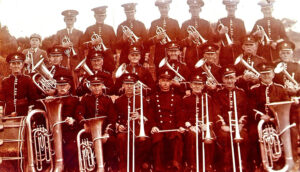 St Agnes Silver Band at St Agnes Carnival on the 12th August 1939 with Charlie seated on the left
St Agnes Silver Band at St Agnes Carnival on the 12th August 1939 with Charlie seated on the left
Immediately after the Second World War, Frank Moore was appointed musical director of St Agnes Silver Band. He had been a playing member and Charlie’s colleague for many years.
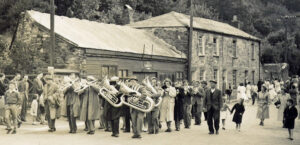 St Agnes Silver Band soon after the Second World War – before being re-equipped with uniforms – Charles Chegwyn is nearest the camera with the largest instrument and wearing his signature trilby hat
St Agnes Silver Band soon after the Second World War – before being re-equipped with uniforms – Charles Chegwyn is nearest the camera with the largest instrument and wearing his signature trilby hat
The inclusion of females was a particularly contentious point in many bands but bandmaster Frank Moore had been trying for a while to persuade twins Dot and Maud Juleff to join St Agnes Band. In 1948, at the age of sixteen, they did. Although they were quite young, they were aware that their presence produced mixed feelings amongst the other players but they decided to stick it out. Maude said, “Some of the men were clearly put out and even ‘Boss’ Chegwyn was not too welcoming initially. Many of them accepted the situation after a while but there were a few who never got used to the idea.”
In 1948 St Agnes Band commemorated Charlie’s 40 years membership by presenting him with a clock. It now resides in the St Agnes Museum and I am grateful to the Trust for allowing me to include a photograph of it in this article.
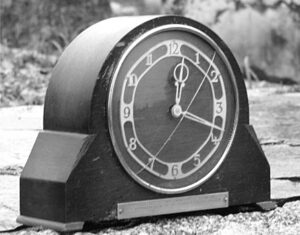 The inscription at the base reads: “Presented to Mr Charles Chegwyn in appreciation of 40 years of Faithful Service with the St Agnes Town Band, 1948”
The inscription at the base reads: “Presented to Mr Charles Chegwyn in appreciation of 40 years of Faithful Service with the St Agnes Town Band, 1948”
The Cornishman newspaper of the 10th February 1949 reported that the Bandmaster of St Agnes Town Band (Mr F Moore) told the annual meeting of the good progress being made by the young players. Membership stood at 24 with three probationers. Mr C Chegwyn, the honorary treasurer, reported a credit balance of over £84. We believe that Charlie had been the treasurer from the band’s inception in which case his tenure had been 41 years at this time.
Desmond Moore, tenor horn player at St Agnes, recalled that treasurer Charlie Chegwyn had a good system of cashflow control. During a break in rehearsal one evening, Frank Moore asked him to make a payment to someone. He was lighting his pipe at the time and said, “Alright Pard, I’ll make a note of it to remind me”. Surrounded by a cloud of smoke he wrote it on the back of his Swan Vestas matchbox. By the end of the session, he had used up all the matches in trying to keep his pipe going and later, outside, he tossed the empty box into the bin. Man or boy, male or female, he invariably called them “Pard”.
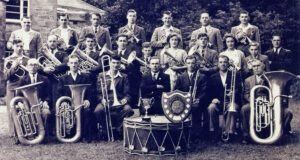 St Agnes Town Band 1949, awaiting new uniforms
St Agnes Town Band 1949, awaiting new uniforms
Back row: Alfie Kneebone, Clifford Bolitho, Frank Roberts, Tony Williams, Tony Oliver, Ken White, and Ronnie Matthews
Middle row: Austin Tremain, Cecil Tremain, Raymond Gribben, Reggie Leach, Ronald Williams, Maude Juleff
Bernard Gribben, Dot Juleff, Desmond Russell, Carlos Robins
Front row: Russell Berryman, Clifford Williams, Gerald Willcocks, Frank Moore (MD), Edward Ely, Frank Kneebone, Charlie Chegwyn
On the concert stage or during rehearsal, when not being played, it was normal to rest a bass instrument on its bell end. On an uneven surface such as a tea treat field, however, it was safer to lay it on its side. Charlie did just that when he went for his tea at Mithian tea treat. On returning he picked up his bass and made ready to recommence playing. Something was clearly wrong and he soon discovered that a young rabbit had taken up residence in the tubing. The band had already started playing but as Charlie reached inside the bell end and pulled out the frightened animal they could not continue for laughing.
When marching, the trombones and a bass or two are in the front row. Clifford Bolitho, cornet player at St Agnes, recalled an occasion when Charlie was sure that he knew the route but unfortunately he turned left when the rest of the band turned right. He said, “We had to go and grab him before he’d gone too far”. Clifford also recalled an occasion when the road was quite narrow and Charlie ended up in the ditch. However, that didn’t stop him marching and playing and he continued on until he had an opportunity to clamber out.
By 1950, Charlie was still the treasurer but he was paving the way for a successor. Ronnie Matthews, euphonium player at St Agnes, was appointed as his assistant for a year before taking over the role. Ron recalled that the books were in a bit of a state but that it quickly became clear that Charlie had been using his own money to keep the band solvent.
In September 1908, Charlie received a letter which must have both surprised, and then delighted him: it was from Peter Clarke, the Chairman of the National Brass Band Club.
Dear Mr Chegwyn. As chairman of the National Brass Band Club, it is with great pleasure
that I extend to you the congratulations of the executive on your having completed over
50 years in the service of our glorious brass band movement.
The club is proud to confer on you an Honorary Membership and I am greatly privileged to
add to that well deserved honour these few words of congratulation and of thanks to you for a
lifetime of devoted service and achievement in raising the standard of culture and bringing pleasure to your fellows by your performance of music.
It is the executive’s earnest wish that you may be spared for many years in good health
to continue your interest in the splendid cause to which you have contributed so much.
The letter was accompanied by this certificate.

Like the members of a military band, brass band players expect to be dressed in their own individually styled uniforms. This, if you like, is the “house colour” and is how the band is identified at contests and other functions. Over the years, St Agnes Band has had many uniforms and there is a reference to long-serving Charles Chegwyn having worn five different ones. These were not necessarily new, some, if not all, were obtained second-hand from military sources including the red tops and navy-blue trousers of the 1930s which were purchased for a nominal sum from either the Scots or Irish Guards. By 1949, the old uniforms were in “some state” and new ones were urgently needed. The replacements were dark blue, of very thick material with high collars fastened at the throat by a hook and eye. This was to be Charlie’s last uniform and, a few years later, my first. There was a lot of braiding and brass buttons and I recall having to clean these frequently using a button guard and Brasso. The hats were very uncomfortable and many needed packing with folded strips of newspapers to make them fit. At the time, band funds were low so interest free loans were requested and players and supporters lent what they could afford in units of 10/- (50p).
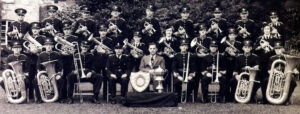 St Agnes Band in new uniforms 1950 with Charlie in the front row on the extreme right
St Agnes Band in new uniforms 1950 with Charlie in the front row on the extreme right
 St Agnes Town Band circa 1955
St Agnes Town Band circa 1955
Back row: Alfie Kneebone, Clifford Bolitho, Ronnie Luke, Tony Williams, Desmond Russell, Roy Marsh, Ken White, Courtney Berryman, Alfie Woolcock, Catherine Southwell
Middle row: Bill Southwell, Lewis Ely (Vice President), David Boundy, Bernard Gribben, Ronnie Matthews, Desmond Moore, Tony Oliver, Ronald Williams, Austin Tremain, H Stowell (Vice President), Percy Cheesley
Front row: Charles Chegwyn, Cecil Tremain, S Matthews, Maurice Bizley (President), Frank Moore (Musical Director), Edward Ely, Reggie Leach, John Gribble, Ernest Robinson
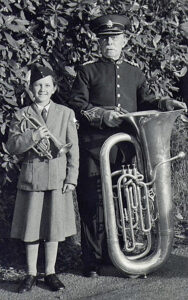 Catherine Southwell (flugel) and Charlie Chegwyn – the youngest and oldest members
Catherine Southwell (flugel) and Charlie Chegwyn – the youngest and oldest members
 Off to a contest. The band’s name displayed on the side of the coach suggests that their destination is one of the contests. The caption to this 1955 photograph is “Youngest and oldest” as it shows 10-year-old Catherine Southwell with Charlie Chegwyn aged 86 and still playing. (Photo: Ken Young)
Off to a contest. The band’s name displayed on the side of the coach suggests that their destination is one of the contests. The caption to this 1955 photograph is “Youngest and oldest” as it shows 10-year-old Catherine Southwell with Charlie Chegwyn aged 86 and still playing. (Photo: Ken Young)
In 1955, St Agnes Band competed in the third section (now the second section – third level) of the West of England Regional Brass Band Championships of Great Britain at Exeter and were accompanied by two coaches filled with supporters. The West Briton and Cornwall Advertiser of the 19th May 1955 reported: “The band had the distinction of having in Mr Charles Chegwyn, who was 86 last December, and has been a player for 73 years, the oldest player participating”. During the day, Charlie became separated from his colleagues and after much searching they discovered that the BBC had shepherded him away for an interview. He had been singled out because of his age and length of service. When the results were declared, they were placed second and had qualified for the national finals. Unfortunately, they subsequently withdrew because of the cost of transport and accommodation.
Redruth Carnival route was always particularly long. The procession started in the main street, went out to Mount Ambrose and back to the main street via Drump Road and Green Lane. It then continued along Clinton Road and back again. Charlie marched the full route and, despite his advancing years, he never complained. Tea treats, too, often involved lengthy marches which always seemed longer because it was often a case of playing to the hedgerows, and the cows, rather than to people-lined streets. Charlie hardly ever missed a practice night or an engagement but on one occasion he’d been absent for a while recovering from a bout of illness. He returned for a parade and as they were about to set off, Frank Moore turned to him and said, “How far shall we march today, Boss?” Charlie, never keen to be seen as the weak link, replied, “March as far as you gotta mind to, Pard”. However, his age was beginning to tell and when seated, he often held his bass horizontal across his lap rather than in an upright position: an understandable concession to someone of his advanced years.
Under the heading of “Active still”, the West Briton and Cornwall Advertiser of the 29th December 1955 reported: “Mr Charles Chegwyn of Churchtown, St Agnes, who celebrated his 87th birthday yesterday (Wednesday), is still a playing member of St Agnes Town Silver Band and is one of the oldest active bandsmen in the country. For more than half a century Mr Chegwyn has been in business at St Agnes as a mason and builder.”
Many of his colleagues recalled the night Charlie gave up playing – it was a poignant moment and one that lingers in the mind. It was in 1955, the band was rehearsing a piece which included some tricky semiquaver runs for the basses. Charlie was clearly struggling and just couldn’t get it right. After a few failed attempts he said, “Tis no good Pard. I can’t read the notes fast enough”. Then, with tears rolling down his face, he said, “I’m goin’ to have to pack it in”. Cornet player Austin Tremain said, “There wasn’t a dry eye in the room. You could have heard a pin drop as he put his instrument down and headed for the door”. It was clearly as emotional for his colleagues as it was for him and even after all this time the drama of the moment can still be felt. A few weeks later he returned to listen but he never played again.
There was, however, some consolation for Charlie and under the heading of “Oldest Bandsman Honoured”, the West Briton and Cornwall Advertiser of the 2nd February 1956, reported that St Agnes Town Silver Band had elected Mr Charles Chegwyn to life membership. “Because of failing eyesight, Mr Chegwyn, who is 87, has handed over his double bass instrument after having been a playing member for nearly 50 years. The musical director, Mr F E Moore, said that Mr Chegwyn had probably been the oldest active bandsman in the country. He had not resigned his membership and still continued to take a keen interest. The chairman, Mr H Stowell, said Mr Chegwyn’s record with the band must be almost without parallel.”
My brother, David Bunney, wrote an essay about Charlie for a Gorsedh Kernow competition and I remember accompanying him on one of the interviews. I had just begun playing third cornet and Charlie looked at me and said, “I suppose you want to play solo cornet as soon as possible. Well don’t be in too much hurry, every part is important.” I still remember that advice.
On the 5th March 1958 Charlie’s wife died. He had clearly missed the camaraderie of his fellow band members and now he had lost his Bessie, his life-long partner. Sad days for this old chap but he continued to make the best of life and to mix as much as possible. After all, he was well-known in St Agnes, both as a bandsman and as a builder, and he was still a familiar sight as he toddled off down to the St Agnes Hotel for his daily noontime pint.
On the 31st December 1959 the West Briton reported: “Many congratulations have been received by Mr Charles Chegwyn of 2 Churchtown, St Agnes, on the celebration on Sunday of his 91st birthday. Well and active, Mr Chegwyn is a familiar and respected resident who still takes daily walks. He retains his keen interest in the Town Silver Band, of which for half a century he was a playing member. Mr Chegwyn is a retired builder.”
During the late 1950s and early 1960s, Clifford Bolitho, the junior band trainer, remembered Charlie attending rehearsals to “help out the youngsters”. Clifford said, “I don’t remember too many of the other established players doing that”.
Helen Benney of St Agnes recalled that her grandmother, Dorothy May Harris, cooked dinner for Charlie every day, presumably following Bessie’s death. Dorothy was married to local butcher Jimmy Harris, and when Charlie died he remembered her in his will. Helen said that her grandmother told her that Charlie liked mustard, so much so that he “lathered” his food with it. After his meal Dorothy would ask him if he had had enough to eat and he would always say, “Yep, full up Mrs”.
Courtney Berryman, St Agnes Band euphonium player for many years, had vivid memories of Charlie. “Well, Charlie, he was a character, well known in St Agnes mind. Charlie did what he wanted to do and if he didn’t want to do it, he wouldn’t do it. I was with him when a lady asked him when he was going to look at her kitchen. ‘Dunno’, said Charlie. Pressing him for an answer she asked him if he could manage it the next week but, ‘Can’t tell’, was all she could get out of him. Apparently he cycled to work when he was working in Saltash – on his old boneshaker. He said to me, ‘Well Pard, tis like this, they never had proper roads when I was riding that thing and the number of times I’ve gone over the handlebars with a wheel in a rut is nobody’s business’. He was a masterpiece for timekeeping. We’d often sit on the seat outside the Miners and Mechanics Institute and all of a sudden he would put his stick down and get up. ‘Well Pard, ‘tis time to make a move’. I’d look at my watch and it was always ten to one. He had a pint waiting for him at one o’clock down at the St Agnes Hotel. He never looked at his watch until after he got up but he was never late. He played BB♭ bass but he was a bit short and they had to alter the level of the mouthpiece so he could reach it. After a while he found it easier to hold the instrument flat across his lap. Charlie was a bit hard of hearing and would often ask, ‘What we playing now then Frank?’ The reply on one occasion was a piece of music called Throw open wide your windows. ‘Aw, aw,’ said Charlie, ‘throw out yer windows!’ Either he hadn’t heard or it was his dry sense of humour. Yeh, he was a beauty, a character, they don’t make them like that anymore.”
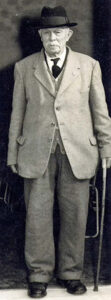 All things come to an end – Charlie after he had retired from the band
All things come to an end – Charlie after he had retired from the band
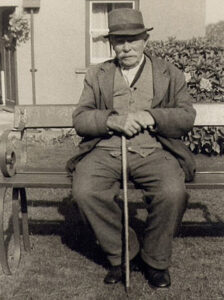 Charles Chegwyn 8th February 1956
Charles Chegwyn 8th February 1956
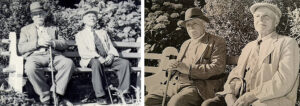 1959: Charles Chegwyn and Matt Radcliffe – two great servants of St Agnes Band (Photos: Ken Young) The photo on the right was included in the West Briton with this caption: “Mr Charles Chegwyn (91) of Churchtown, and Mr M P Radcliffe, of Town-hill, (who will be 89 tomorrow), two esteemed residents of St Agnes, enjoying a rest in the sunshine. Both of them well and active, Mr Radcliffe and his old friend meet frequently for talks about St Agnes of other days.”
1959: Charles Chegwyn and Matt Radcliffe – two great servants of St Agnes Band (Photos: Ken Young) The photo on the right was included in the West Briton with this caption: “Mr Charles Chegwyn (91) of Churchtown, and Mr M P Radcliffe, of Town-hill, (who will be 89 tomorrow), two esteemed residents of St Agnes, enjoying a rest in the sunshine. Both of them well and active, Mr Radcliffe and his old friend meet frequently for talks about St Agnes of other days.”
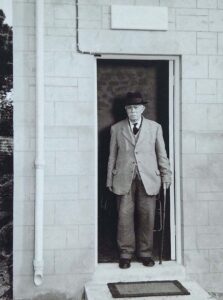 Charlie in the band room doorway
Charlie in the band room doorway
Charles Chegwyn died in the evening of the 8th February 1965 – he had been sitting in his chair after having been out and about during the day. He was 96 years old. At his funeral, the band played two of his favourite hymns: one in the church and one at his graveside: The day thou gave us Lord is ended. His funeral brought forth many tributes and the attendance by St Agnes Town Band was much appreciated both for the playing of the hymns and for providing the six bearers which included my brother, and myself. A memory which still causes me to shiver is that whilst standing at the graveside, my foot slipped and it was touch and go whether I or Charlie would reach the bottom of the grave first. Luckily, one of the other bearers grabbed my arm and I recovered my balance, if not my dignity.
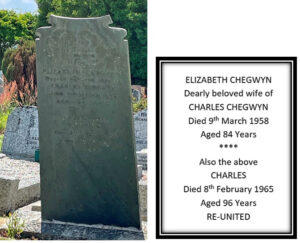 The Chegwyn’s grave at St Agnes
The Chegwyn’s grave at St Agnes
Helen Benney, a young girl at the time, has vague memories of a group of people, including her father Claude Tonkin, Dorothy’s son, clearing the unwanted contents of Charlie’s house and putting them on a bonfire in the garden.
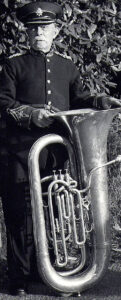 Charlie with his beloved bass, the instrument that David Bunney (my brother) took over after Charlie’s death
Charlie with his beloved bass, the instrument that David Bunney (my brother) took over after Charlie’s death
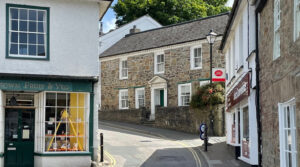 Number two churchtown – Chegwyn’s. In The Story of a Village Street by Frank Carpenter it states: “This attractive Georgian fronted house is named after Charlie Chegwyn, a former resident. Until the mid-1930s it was known as Ivy House or Ivy Cottage and was built about 1750 and restored in 1967 by Gordon Round”. It seems likely that the property received its new name when the restoration took place – in 1967. A fitting gesture to one of the village’s characters.
Number two churchtown – Chegwyn’s. In The Story of a Village Street by Frank Carpenter it states: “This attractive Georgian fronted house is named after Charlie Chegwyn, a former resident. Until the mid-1930s it was known as Ivy House or Ivy Cottage and was built about 1750 and restored in 1967 by Gordon Round”. It seems likely that the property received its new name when the restoration took place – in 1967. A fitting gesture to one of the village’s characters.
A little further up the street is Chegwyn Gardens: the site of Charlie’s garden and stable. It is now a delightful remembrance garden created by another much-loved St Agnes man, the late George Mannell.
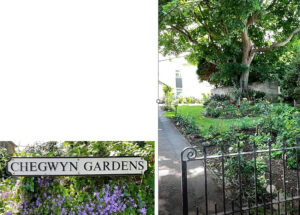
The band members who played at the same time as Charlie described him as “easy going” and “mild mannered”. An unassuming man who had great respect for everyone and rarely raised his voice in disagreement with others. He was, as one said, “one of the best”.
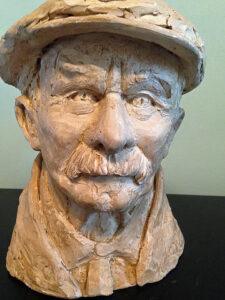 Charlie Chegwyn’s bust – by N Homer (Courtesy Dean Woon)
Charlie Chegwyn’s bust – by N Homer (Courtesy Dean Woon)
Now, in 2024, it is almost 60 years since Charlie died. Memories fade but if you do remember him in his final years it will most likely be of him sitting in the St Agnes Hotel, supping his pint, or perhaps in his front garden, leaning on his walking stick, chatting to passers-by.
Acknowledgements:
I am greatly indebted to the following:
Susan Coney of Truro for her considerable help with the Chegwyn, Tregellas and Paddy research.
Paula Ford, Charlie’s great niece.
Clive Benney, Roger Radcliffe and Peter “Nick” Thomas for their help in determining the location of Wheal Rock.
Clive Benney who provided most of the photographs.
Those who provided information whether acknowledged or not.
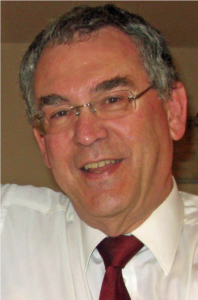
Tony Mansell is the author of several books on aspects of Cornish history. In 2011 he was made a Bardh Kernow (Cornish Bard) for his writing and research, taking the name of Skrifer Istori. He has a wide interest in Cornish history, is a researcher with the Cornish National Music Archive and a sub-editor with Cornish Story.
